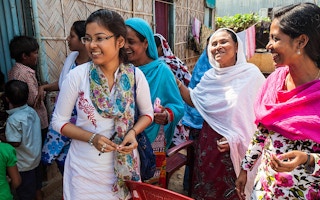The 17 Sustainable Development Goals (SDGs) that came into effect last year hold the promise of improving the lives of poor and marginalised communities worldwide, particularly in urban areas. Yet as national and local governments turn to implementing this far-ranging agenda, there is growing concern that current statistical capacities are not up to the task of monitoring their progress.
Last week, the United Nations convened a first-ever global data summit, where governments agreed to work to fill this gap. For the most part, however, their pledges aimed at national-level capacity, with a bit of reference to cities, as well.
Yet others are focusing on an entirely different realm of data production and bottoms-up oversight. Making Citizen Generated Data Work, a report published last month, explores how urban residents can help keep tabs on the SDGs — and, hopefully, inform what’s working and what isn’t.
The report was published by DataShift, an initiative that supports grass-roots data collection, and Open Knowledge, a global non-profit that promotes shared information.
For multiple reasons, citizen-generated data is a tricky proposition. In order for citizen involvement to be effective, partnerships with government entities whose data would be strengthened by the collaboration are essential, the report says.
The intelligence also must be gathered under a “rigorous” and transparent methodology that safeguards privacy. Further, support systems should be in place to educate and encourage people about online information portals.
Some citizens will participate for free if they’re motivated by a social cause or community commitment. But to spur wider public involvement, cities can offer incentives such as modest stipends that cover basic costs. “Citizens will contribute data if it benefits them,” the report states.
To protect participants, however, municipalities should never use the information gathered to disparage — much less retaliate against — citizens. Local governments also are urged to provide the public with regular feedback about data initiatives.
Among the key recommendations:
· Have well-defined goals in mind for the data collection to solve.
· Make the raw information accessible to multiple stakeholders.
· Disseminate data in an “interoperable format” that enables statistics to be used for varied purposes.
· Favour existing technologies that citizens and governments commonly use.
· Incorporate data into bureaucratic processes and community forums.
An example of a successful public-private partnership in this regard is the Mobile Birth Registration effort in Tanzania, the report says. The project is spearheaded by UNICEF, the Tanzanian government, the Dar es Salaam-based mobile phone operator Tigo and VSO International, a London-based international development organisation.
The project aims to make birth registration quicker and simpler for youngsters under 5. Rather than travelling what can be long distances to district offices to register newborns, parents can accomplish the task at local hospitals and health clinics. Registration officers simply send the data via text message to a national government database.
Still, for such data to be effective, the report advises, it must be gathered and analysed under a standard methodology. That way, it can be compared across nations and metro regions over a lengthy time frame.
Ultimately, the authors are keen to warn against over-reliance on national governments and national statistical offices to monitor progress of SDGs. For starters, it’s an expensive task, and many developing nations have limited resources and funding options.
There’s also the issue of perspective. Those bodies are more inclined to overlook the concerns of everyday citizens or minimise corruption, inequality and human rights violations, the report says.
When used effectively, citizen-generated data holds the potential to reshape cities, the authors say. It can spotlight new or overlooked issues, offer a viewpoint that differs from the establishment and ensure that all voices are represented.
This story was published with permission from Citiscope, a nonprofit news outlet that covers innovations in cities around the world. More at Citiscope.org.










